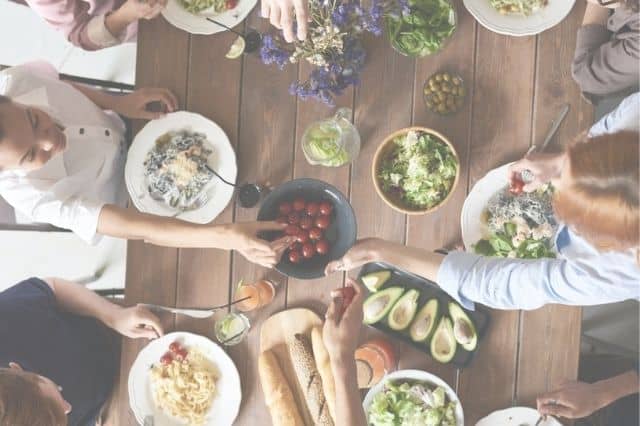How To Change Your Eating Habits Forever: Your Ultimate Guide
Has the thought, “I really should change my eating habits” been floating around in your brain for quite some time now? Or maybe your doctor has suggested changing your eating habits to help maintain an ideal body weight, or help prevent or even reverse disease?
You might even be someone who usually eats healthy but finds it to be more challenging than it should be.
This comprehensive guide on how to change your eating habits forever, is for you then. I’ll admit, it’s a little long, but here is a long list of benefits you’ll get from reading it!
By the end, you will be an expert in the following:
- Understanding why you should improve your eating habits
- Be clear on the difference between “good” and “bad” eating habits
- Differentiating between healthy and unhealthy foods
- Understanding why poor eating habits aren’t your fault
- Establishing WHY you may be eating poorly (and resolving this)
- Determining your reasons to want to eat better
- Understanding how to have better eating habits and set yourself up for success
- Mastering how to have better eating habits when you are NOT at home
- Discovering how to change your eating habits permanently
- Knowing what to do if you “fall off the wagon”
Why You’ll Want to Improve Your Eating Habits
Most of us have grown up hearing “eat your vegetables”, “eat less sugar”, and “avoid fried foods.” Well, why are vegetables important and why are fried foods bad?
In short, our bodies need certain nutrients for our organs to function well. A nutrient is defined as “a substance that provides nourishment essential for growth and maintenance of life,” according to Oxford Languages (Google’s English Dictionary).
When we don’t have the nutrients we need to function well, our bodies start developing diseases. Such diseases include cancer, cardiovascular disease, hypertension, diabetes, autoimmune disease, Alzheimer’s, Anxiety, Depression, and more.
Substances such as sugar wreak all kinds of havoc and even increase undesirable inflammatory processes in your body. In my clinical practice, I’ve even seen patients improve their chronic pain simply by exchanging bread and pasta for vegetables and beans, due to their anti-inflammatory effects.
- RELATED: How Healthy Eating Habits Save Time
Definition of “Good” Eating Habits
“Good” eating habits in its simplest form means consistently eating foods that are high in nutrients (a.k.a. “healthy foods”) and not eating more calories than your body needs. These can be further broken down, which I will explain in the coming section about “How to Eat Better and Set Yourself Up for Success.”
Examples of healthy foods are:
- Vegetables
- Fruits
- Whole Grains (grains that are literally still “whole” rather than processed into a flour)
- Nuts/Seeds
- Fish
- Lean land animals
*If you are interested in the current research supporting the consumption of animal protein, here is an excellent article about animal protein written by Lindsay Christensen, M.S., CNS.

Definition of “Bad” Eating Habits
“Bad” eating habits means consistently eating foods that have minimal nutrients and contribute most to disease (a.k.a. unhealthy foods), and eating more calories than your body needs. There are many reasons for bad eating habits, which I will explain in a bit.
Examples of unhealthy foods are:
- Any foods that are high in saturated fats (bacon, butter, fatty cut of steak, etc.)
- Foods with processed or refined sugar, which means sugar that is not in its natural, whole food form (candy, baked goods, soda, syrup, ketchup, etc.)
- Also, foods that have a list of ingredients that you cannot pronounce easily (they look like names of chemicals for a reason….because they are.)
Why “Bad” Eating Habits Aren’t Your Fault
There is a lot of shame and self-judgement associated with eating poorly. This just creates negative emotions, which can lead to more unhealthy eating to try to make the negative emotion “disappear.”
The following are reasons why you should stop placing blame on yourself and stop the negative self-talk. It’s not fair to yourself and is very counter-productive. You may even develop a habit of negative self talk. (I can help you break that habit too, but who needs another not-so-great habit?)
Our Brains Were Created to Crave Sugar
Our ancestors, “the cave people” had to scavenge for their food, particularly food that was a significant source of energy such as glucose, which is sugar. Therefore, to help our ancestors to survive, our brains had to evolve in such a way that sugar was pleasurable to eat. This resulted in a reward system in our brains called the mesolimbic dopamine system.
How this system works is, when you eat something pleasurable, such as a warm, gooey chocolate chip cookie, the mesolimbic dopamine system becomes activated. This then leads to the release of dopamine.
Dopamine is a neurotransmitter, or messenger, that plays a large role in pleasure. This release of dopamine signals to our brain that the chocolate chip cookie was pleasurable (the reward) and creates the desire to re-create that feeling of pleasure again. When this reward system is activated multiple times, it ends up resulting in a “re-wiring” of our brain, called neuroplasticity.
This unfortunately results in a sort of tolerance to the pleasurable entity (in this case the cookie) and your mesolimbic dopamine system now requires more cookies, frosted donuts, cake, and Reese’s peanut butter cups to get the same amount of pleasure.
Reference: Neuroscience News
Manipulative Food Advertisements
Food companies have one main goal, to make money. To make money, they need us, the consumer, to crave their product. If we crave their product, we will keep buying it. To guarantee that this happens, they make their advertisements extremely enticing, and their food as “addictive” as possible. Both affect our brains and create those cravings.
Disturbingly, many food companies even advertise heavily to children, knowing that they have their full attention while watching cartoons, YouTube videos, etc.
Misleading Labels On Packaged Foods
Many packaged foods have labels such as “sugar free”, “organic”, “non-GMO”, and “reduced fat.” These labels don’t necessarily mean the food itself is healthy.
In fact, oftentimes the food isn’t heathy, because of significant processing of the ingredients resulting in reduction of nutrients. Also, the addition of chemicals, such as preservatives, is very common and not something we want in our bodies.
Another issue is inaccuracy of calorie amounts on the nutrition labels. Did you know that the FDA (Food and Drug Administration) allows food companies to mislabel the number of calories by up to 20%? They can do this in either direction, but they’re going to want you to think the food is lower calorie than it really is.
Now that we have defined “good” and “bad” eating habits, healthy and unhealthy foods, and learned the nerdy stuff, let’s get to the system you can use to create BETTER eating habits.
Explore WHY You May Have Poor Eating Habits
Start with identifying what your poor eating habit is. To do this, go back to the two basic components of “bad” eating habits. Do you believe you eat too many of the unhealthy foods listed above and not enough of the healthy foods? Or do you believe that you may be consuming too many calories?
If you eat too many unhealthy foods, try to see why or when you eat these foods. Do you eat them when you are stressed? Lonely? Bored? Do you eat them while you work? Do you eat them late at night when watching TV?
Once you determine your why or when, this is the root of the issue. Try to think of something you can do to remedy the issue.
Examples of Remedies:
If it’s boredom, then find an activity that you can do that will stimulate your mind. Examples are reading more of my blog posts, looking up new healthy recipes to try (wink wink), etc.
If it’s loneliness, then perhaps call a friend, family member, or write a letter to a loved one (or yourself!). Maybe look for a group to join that shares a similar interest as you.
If it’s stress, find an alternate stress reliever, such a meditation (there are great apps such as Insight Timer, which is my favorite). Or maybe drawing or painting, reading, writing in a journal, or having a good conversation with a friend.
Mindless snacking while working or watching TV? then make some soothing tea or maybe some sparkling water with fruit, to sip instead.
Establish WHY You Want to Eat Better
Set your intentions for why you want to eat healthier. For example, do you wish to feel less tired, lower your risk of heart disease, feel more self-confident?
Make a list with your number one reason at the top, and any additional reasons underneath it. When you can see what your motivators are, you are better able to visualize the reward.
Also, if you are setting a long-term goal, such as weight loss, pick the exact amount you wish to lose by which date. That way, your progress is measurable.
If it is higher energy levels that you wish to attain, then keep track of your energy level. You can do this in a journal, daily or weekly, and use a scale of 1 to 10 (10 being very energetic) to track your energy.
Those are just a couple of examples, so really think about why you really want to eat healthier. Be sure to choose something that is for you, not for someone else. That is the best way to maintain motivation in the beginning when your brain isn’t quite in line with the new changes yet.

How to Eat Better and Set Yourself Up for Success
Now that you have the foundation work done, it is time to learn some tips to make eating healthier a habit, rather than a struggle. There are a few things that will make it easier for your brain to choose to eat healthy, rather than be drawn to the unhealthy options.
Set Up Your Environment
This is probably the most important key to being successful in creating your new healthier eating habits.
If your kitchen is filled with Oreos, barbecue potato chips, and Dr. Pepper, you will keep eating and drinking these items. That wouldn’t be your fault either. Remember that mesolimbic dopamine system and resultant neuroplasticity I talked about earlier? Try to slowly replace the unhealthy options in your home with healthy ones.
Habit Tips:
- Make a habit of shopping along the perimeter of the store. If you think about the layout of grocery stores, the fruit, vegetables, meat, eggs, and yogurt are on the perimeter. If you need to go into the aisles to grab items like olive oil and beans, then avoid the cookie and cracker aisles.
- Put the healthy foods front and center and at eye level in your refrigerator and pantry. Put any treats such as chocolate in a hard to see, hard to reach location. If you make it easy to grab the strawberries for a quick snack, it’ll be easy to do. If you make it difficult to grab the chocolate, you avoid it more. (Our brains were made to take the easy way.)
Start Making Small Additions, Rather Than Subtractions
Add in healthy foods in small amounts, rather than subtract initially. It’s more difficult to “break” the habit of eating something salty or sugary, than it is to start eating something like a small handful of grapes.
Also, if you are simply adding in a tiny bit of fruit or vegetable daily, you will still feel full, since you have not removed anything from your diet yet. (Of note, the addition of a little bit of fruit or vegetable only adds a negligible amount of calories.)
Habit Tip:
- Start to increase the amount of fruit or vegetable you are eating so that you start filling up more on these high-nutrient, low-calorie foods. You will no longer have a need (or desire) to fill up on the unhealthier options such as potato chips, pasta, cheese and crackers, etc.
When You Eat, Just Focus on Eating
With our days being so busy, it seems like a good idea to multitask to get more done. For this reason, many people will eat while they do another activity. This is not a good habit to get into. The reason is that if you are concentrating on another task (even if it’s watching a movie), you aren’t paying attention to how much you are eating.
Think mindful eating rather than mindless eating. Being mindful means being aware of what your food choices are, how much you are eating, and recognizing that you are full. Also, it allows you to enjoy the food.
How many times have you eaten while doing something else and before you know it, the last bite is gone? (That has happened to me more times than I care to admit.)
- RELATED: How to Eat Mindfully, for Busy Women
Habit Tip:
- Cut your food into smaller pieces and put your fork down while you are chewing. This assists with enjoying the food and allowing your brain to sense when you are full to prevent over-consumption.
Plan What You Will Eat Ahead of Time
Planning and decision making that determines behavior, is largely due to a part of our brain called the prefrontal cortex.
When our brain has a set plan, it is less likely to eat just for that dopamine hit that you learned about earlier. It is more likely to follow through with the pre-determined plan of making the healthy choices, especially when there is a reward associated with the behavior. The reward in most cases being satisfaction that you stayed on course and kept your promise to yourself to eat healthier.
Portion Control
A common misconception about portion control is that it means smaller portions. This may be the case with certain foods. However, a more accurate description would be being aware of how much of a food you are eating and having complete control of this.
For example, if you are eating straight out of a bag of chips, you don’t know what your portion size really is, because it is much more difficult to measure (unless you end up eating the entire bag….yikes!).
The reason why you would want to control your portions, is mainly to control the amount of calories consumed. Another reason is that if you are trying to minimize salt, sugar, and fat intake, you would want to make sure the amounts you are consuming are measurable and controlled by you.

Habit Tips:
- Use a small Tupperware, cup, or ramekin for snacks, rather than eat out of a bag or box.
- If you feel that you eat large meals that leaving you feeling very full, bloated, or cause stomach pain, then use a smaller plate. Once finished with that plate, put your fork in the sink or dishwasher, so you are less likely to go for seconds.
- Fill most of your plate with vegetables first, then use remaining room for the other foods on the table.
Be Wary of Beverages
Keep in mind that beverages other than water, unsweetened tea, and seltzer water have calories, with those calories oftentimes being from sugar. (Coffee has some calories, but not due to sugar.)
Alcoholic beverages are significantly high in calories, especially fancy cocktails. These can have as many calories as your breakfast or lunch you had that day, so is it really worth it?

Habit Tip:
- Always check the nutrition label on any beverage other than the ones listed above.
- If you prefer not to drink your calories, stay away from fancy flavored coffee drinks, as they are often high in calories.
- Avoid alcoholic cocktails altogether or choose a glass of wine or a light beer if you want to still enjoy happy hour without the massive calorie consumption.
- Substitute soda for seltzer water and if you feel that you need a bit more flavor, then muddle up some fruit for the seltzer.
How to Eat Better When Not at Home
You might be asking, “well of course it’s easier to eat healthier when there are healthy foods in my home, but what about when I’m not home?” I have a few tips for you that will help you to maintain your healthy nutrition changes no matter where you are.
Work
Pack your own lunch and snacks to bring to work. If you think you might struggle with developing the habit to pack your lunch daily, then start small. Start just packing your lunch every Monday for a month. Then pack your lunch every Monday and Tuesday (or choose which days you prefer) for a month. Continue building until it’s a habit to pack your lunch daily.
On the Road
Pack healthy snacks and sandwiches rather than stopping at convenience stores or fast food joints. It’s that simple.
Vacation
As most accommodations have at least a small refrigerator, stop at the grocery store on your way to the hotel or AirBnB, stock up on healthy breakfast foods, ingredients to make sandwiches, and healthy snacks. Then, treat yourself to going out for dinner each night on vacation.
The benefits are, you won’t be as likely to gain weight on vacation, you’ll save money, and going out for dinner will seem more like a treat if you aren’t eating out for every meal. (My husband and I do this for every vacation and we end up coming home weighing a pound or two less!)
Social Gatherings
Eat a healthy meal at home before you go, and then just treat yourself to some appetizers or a dessert at the gathering later.
If it is a sit-down dinner, fill your plate with mostly vegetables, put your fork down while chewing, and be sure not to ignore your glass of water sitting next to that glass of wine.

How to Change Your Eating Habits Permanently
Start small and grow from there. Think about it like exercise. If you are not an experienced weightlifter, you wouldn’t walk up to a barbell and try to deadlift 500 lbs. immediately. You’ll be likely to fail and give up entirely. The same is true for changing your eating habits. You are going to want to ease into it, so that you can create the new habit more easily and maintain it forever.
Remember the reason why you wanted to eat healthier and take notice of your progress. Congratulate yourself even on the small wins (small wins are still wins!). Encouraging words motivate humans to continue doing things that are hard, so self-encouragement can do the same, according to the APA (American Psychological Association).
Also, keep in mind that big results aren’t noticeable right away, but eventually you will reach that point where your results just take off, which helps provide incentive to continue the habit.
Accountability is another way to make your changes permanent.
If you tell your partner, friend, family member or coworker about the changes you are making, you are going to be more likely to continue with the commitment. They can provide words of encouragement and humans being humans, we tend to want to please other people, even more than pleasing ourselves.
Accountability also works the other way too, according to a done in the United Kingdom, when one partner made a healthier change, the other partner was more likely to make a healthy behavior change. So, imagine if both of you decided to make a healthier behavior change, you’ll essentially just be feeding off each other and increase your chances of success.
- RELATED Habit Tracker: A Tool for Success (and your new accountability partner)
What to Do If You “Fall Off the Wagon”
You now have some great information on how to be successful in creating healthier eating habits, but what happens if you miss a day?
Don’t worry about this, missing a day almost has no effect on the ability of your brain to make the new behavior a habit. According to this article on how to form a habit I found in Research Digest, older research suggests that missing a day does not have a profound effect on the ability for the new behavior to become a habit.
So just get right back on that wagon immediately, and continue on as if it didn’t happen. And remember this, “Missing once is an accident. Missing twice is the start of a new habit” (quote from James Clear, author of “Atomic Habits.”)
Final Notes
Whatever your long-term health goals are, nutrition is a certainly wonderful place to start. You can see short-term changes that compound over time.
To improve your health overall, it is important to develop good habits in other areas as well, such as physical activity, stress management, sleep health, productivity, organization, etc. Having a habit coach can help you make lasting changes in all of these areas in order to elevate your life.

KATE JOHNSTON
Certified Habit Coach, PA-C
If you’re a career woman struggling with the frustrations of bad eating habits, you’re in the right place. You can finally feel in-control around food, and with your body and health.
Next steps: Book your free consultation below. I’ll listen and provide a custom plan. If you like it, we’ll execute it together.
